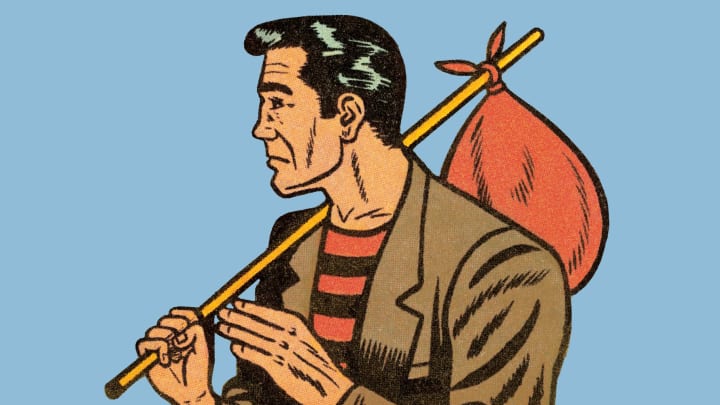The Possible Origins of 7 Odd Visual Clichés
These visual clichés frequently appear in pop culture, but have you ever actually seen a bankrupt man wearing a barrel, or a guy at a party with a lampshade on his head?

Have you ever seen someone throw an old shoe at a stray cat that’s yowling on a backyard fence? Or witnessed a circus elephant rear away in fear when a mouse crosses its path? A whole host of images has become iconic over the decades—thanks to movies, cartoons, and comic strips—despite the fact they’ve never actually been seen in real life (at least by anyone alive and reading this article). Let’s examine a few.
1. Bankrupt Person Wearing a Barrel
The image of a person so destitute that they are reduced to wearing a barrel held up by a pair of suspenders was first popularized by political cartoonist Will Johnstone. His portrayal of “The Taxpayer,” a person from whom the IRS has literally taken the shirt off their back, was published in the New York World Telegram in 1933, and would reappear frequently as the Great Depression continued to wear down America’s morale. In reality, though, barrels aren’t cheap, and the logistics of actually outfitting one for daily wear (not to mention the risk of splinters) make this an unlikely alternative to public nudity.
2. Drinking Champagne Out of a Lady’s Shoe
A sophisticated swain sipping fine champagne from a seductive sylph’s stiletto is the very picture of elegant decadence. Legend has it that this tableau originated at a party held in 1902 at Chicago’s Everleigh Club, one of the nation’s most exclusive brothels at the time. The guest of honor was Prince Henry of Prussia, and during the festivities one of the house “butterflies” (as the working girls employed by the club were called) was dancing on a tabletop to “The Blue Danube” when her slipper flew off her foot and knocked over a bottle of champagne. A member of the prince’s entourage supposedly picked up the slipper and placed it to his lips, sipping the bit of bubbly that had dripped into it. “The darling shouldn’t get her feet wet,” he explained to onlookers. (However, there are also those who say the original champagne-from-a-shoe drinkers were Russian ballerinas of the late 19th century, or members of Toulouse-Lautrec’s set from around the same time.)
3. The Life of the Party Wearing a Lampshade on Their Head
Several years ago, President Barack Obama warned some St. Patrick’s Day partiers at the White House not to get too rambunctious—specifically, to refrain from putting lampshades on their heads—since there were plenty of photographers lurking nearby, and the pictures may well come back to haunt some members of Congress in attendance. It’s impossible to pinpoint when someone donning a lampshade as a hat signaled that the party had officially kicked into high gear, but a 1928 Baltimore Evening Sun piece titled “Life of the Party” seems to indicate that the practice was common enough at the time to warrant a “been there, done that, caught heck from my wife the next day” reaction from readers. Before that, the image likely arose out of vaudeville, and was then popularized by early silent films.
4. A Chef Kissing Their Fingertips
We usually see a chef expressing the perfection of the meal they’ve prepared depicted on restaurant signs or menus—and more often than not, the pictured chef is Italian. The meaning is immediately understood: the food served in this establishment is done to perfection. But outside of any TV/movie restaurant scene featuring Vito Scotti as a gourmand, has anyone ever really witnessed a chef recommending a dish with such a gesture? The cliché itself, however, may have some basis in an actual Italian hand gesture of kissing the fingertips before tossing them away—a move meaning something like “beautiful,” “delicious,” or “as good as a kiss.”
5. Bank Robber with Dollar Sign Sacks
It’s doubtful that any financial institution ever actually transported cash in containers emblazoned with giant dollar signs—in the grand scheme of things, such markings would seem counter to standard security precautions, no? However, in April 2015 a gentleman robbed an Olympia, Washington, Subway restaurant and provided a homemade dollar sign bag to the startled sandwich artist (whom he warned “not to do anything funny,” in film noir fashion). True, he didn’t wear a Lone Ranger mask and horizontally striped shirt while committing his heist, but the local flatfoots nabbed him nevertheless.
6. Kid Running Away from Home with His Belongings on a Stick
The bindle (or “hobo stick”) originated with the vagabonds and migratory workers of the Depression. Hobos were frequently penniless, so they hopped on freight trains and traveled from city to city looking for work. Plastic shopping bags hadn’t yet been invented, so hobos tied their meager belongings into a large kerchief and hung the bundle from a stave or stick for ease of carrying. Somewhere along the way, the hobo stick became a symbol cartoonists used to instantly identify a child as a runaway, as in Norman Rockwell’s famous 1958 Saturday Evening Post cover titled “The Runaway.”
7. A Bomb that Looks Like a Cannonball
Thanks to pop culture staples such as the board game Stratego and MAD Magazine’s “Spy vs. Spy” comic strip, Baby Boomers grew up thinking that all bombs looked like a bowling ball with a fuse sticking out of the top. The cannonball-style bomb does, in fact, have some basis in history; after gunpowder reached Europe in the 1300s, militaries did use dark metal spheres filled with explosives, sometimes designed to be shot out of a cannon. The addition of a loose string wick, however, seems to be a cartoonist’s fantasy.
A version of this story was published in 2017; it has been updated for 2024.
More Stories About Big Questions
manual